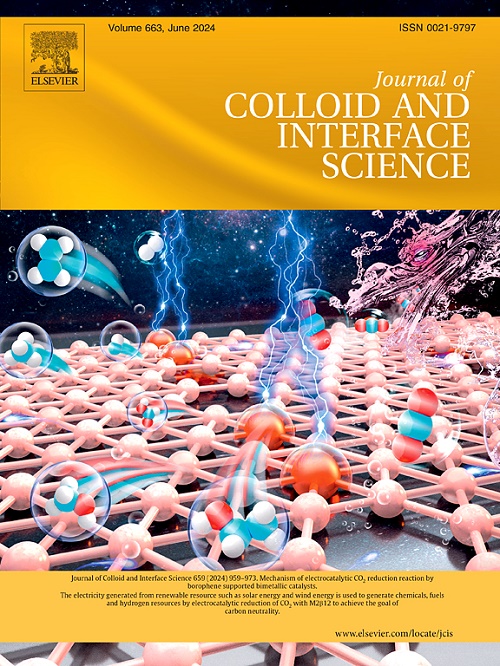疏水柱、孔和空心柱阵列上液滴后退接触角的统一模型。
IF 9.7
1区 化学
Q1 CHEMISTRY, PHYSICAL
引用次数: 0
摘要
假设:目前关于纹理疏水基底上Cassie-Baxter状态液滴后退接触角的模型,仅适用于特定的结构类型,如柱(液滴在柱上有孤立的接触线和连续的液-气界面)或孔(连续的接触线和孤立的液-气界面),缺乏通用性。我们推测,如果能够桥接柱孔之间的基本间隙,就可以建立液滴退去接触角的统一模型。实验:测量了具有柱和孔两种特性的空心柱(柱内孔)阵列上的液滴后退接触角,并与柱和孔阵列上的液滴后退接触角进行了比较。在这些基板上的接触线和液-气界面的微观动力学也被可视化。结果:液滴在空心柱阵列上的接触角比在柱阵列和孔阵列上的接触角要小和大。基于接触线滑动所涉及的微观能量,柱间液-气界面的松弛,以及孔隙上方液-气界面的扩展,建立了一个模型来预测液滴后退接触角,而不考虑表面结构类型(柱、孔和空心柱)或尺寸(尺寸、间距和堆积密度)的变化。本文章由计算机程序翻译,如有差异,请以英文原文为准。

A unified model for droplet receding contact angles on hydrophobic pillar, pore, and hollowed pillar arrays
Hypothesis
Current models for receding contact angles of Cassie-Baxter state droplets on textured hydrophobic substrates are applicable only to a specific structural type, e.g., pillar (above which a droplet has isolated contact line and continuous liquid–vapor interface) or pore (continuous contact line and isolated liquid–vapor interface), signifying a lack of universality. We conjecture that a unified model for droplet receding contact angles can be established if the fundamental gap between pillar and pore can be bridged.
Experiments
Droplet receding contact angles on hollowed pillar (a pore inside a pillar) arrays, which possess the characteristics of both pillar and pore, are measured and compared to those on pillar and pore arrays. The microscopic dynamics of contact line and liquid–vapor interfaces on those substrates are also visualized.
Findings
Droplets on hollowed pillar arrays exhibit smaller and larger contact angles than those on pillar and pore arrays, respectively. Based on microscopic energies involved in contact line sliding, relaxation of liquid–vapor interface between pillars, and extension of liquid–vapor interface above pores, a model is developed to predict the droplet receding contact angles irrespective of the variations in surface structural types (pillar, pore, and hollowed pillar) or dimensions (size, spacing, and packing density).
求助全文
通过发布文献求助,成功后即可免费获取论文全文。
去求助
来源期刊
CiteScore
16.10
自引率
7.10%
发文量
2568
审稿时长
2 months
期刊介绍:
The Journal of Colloid and Interface Science publishes original research findings on the fundamental principles of colloid and interface science, as well as innovative applications in various fields. The criteria for publication include impact, quality, novelty, and originality.
Emphasis:
The journal emphasizes fundamental scientific innovation within the following categories:
A.Colloidal Materials and Nanomaterials
B.Soft Colloidal and Self-Assembly Systems
C.Adsorption, Catalysis, and Electrochemistry
D.Interfacial Processes, Capillarity, and Wetting
E.Biomaterials and Nanomedicine
F.Energy Conversion and Storage, and Environmental Technologies

 求助内容:
求助内容: 应助结果提醒方式:
应助结果提醒方式:


